Andreas Vlachos
Reinforcement Learning for Better Verbalized Confidence in Long-Form Generation
May 29, 2025



Abstract:Hallucination remains a major challenge for the safe and trustworthy deployment of large language models (LLMs) in factual content generation. Prior work has explored confidence estimation as an effective approach to hallucination detection, but often relies on post-hoc self-consistency methods that require computationally expensive sampling. Verbalized confidence offers a more efficient alternative, but existing approaches are largely limited to short-form question answering (QA) tasks and do not generalize well to open-ended generation. In this paper, we propose LoVeC (Long-form Verbalized Confidence), an on-the-fly verbalized confidence estimation method for long-form generation. Specifically, we use reinforcement learning (RL) to train LLMs to append numerical confidence scores to each generated statement, serving as a direct and interpretable signal of the factuality of generation. Our experiments consider both on-policy and off-policy RL methods, including DPO, ORPO, and GRPO, to enhance the model calibration. We introduce two novel evaluation settings, free-form tagging and iterative tagging, to assess different verbalized confidence estimation methods. Experiments on three long-form QA datasets show that our RL-trained models achieve better calibration and generalize robustly across domains. Also, our method is highly efficient, as it only requires adding a few tokens to the output being decoded.
TCP: a Benchmark for Temporal Constraint-Based Planning
May 26, 2025Abstract:Temporal reasoning and planning are essential capabilities for large language models (LLMs), yet most existing benchmarks evaluate them in isolation and under limited forms of complexity. To address this gap, we introduce the Temporal Constraint-based Planning (TCP) benchmark, that jointly assesses both capabilities. Each instance in TCP features a naturalistic dialogue around a collaborative project, where diverse and interdependent temporal constraints are explicitly or implicitly expressed, and models must infer an optimal schedule that satisfies all constraints. To construct TCP, we first generate abstract problem prototypes that are paired with realistic scenarios from various domains and enriched into dialogues using an LLM. A human quality check is performed on a sampled subset to confirm the reliability of our benchmark. We evaluate state-of-the-art LLMs and find that even the strongest models struggle with TCP, highlighting its difficulty and revealing limitations in LLMs' temporal constraint-based planning abilities. We analyze underlying failure cases, open source our benchmark, and hope our findings can inspire future research.
Social Good or Scientific Curiosity? Uncovering the Research Framing Behind NLP Artefacts
May 24, 2025Abstract:Clarifying the research framing of NLP artefacts (e.g., models, datasets, etc.) is crucial to aligning research with practical applications. Recent studies manually analyzed NLP research across domains, showing that few papers explicitly identify key stakeholders, intended uses, or appropriate contexts. In this work, we propose to automate this analysis, developing a three-component system that infers research framings by first extracting key elements (means, ends, stakeholders), then linking them through interpretable rules and contextual reasoning. We evaluate our approach on two domains: automated fact-checking using an existing dataset, and hate speech detection for which we annotate a new dataset-achieving consistent improvements over strong LLM baselines. Finally, we apply our system to recent automated fact-checking papers and uncover three notable trends: a rise in vague or underspecified research goals, increased emphasis on scientific exploration over application, and a shift toward supporting human fact-checkers rather than pursuing full automation.
AVerImaTeC: A Dataset for Automatic Verification of Image-Text Claims with Evidence from the Web
May 23, 2025Abstract:Textual claims are often accompanied by images to enhance their credibility and spread on social media, but this also raises concerns about the spread of misinformation. Existing datasets for automated verification of image-text claims remain limited, as they often consist of synthetic claims and lack evidence annotations to capture the reasoning behind the verdict. In this work, we introduce AVerImaTeC, a dataset consisting of 1,297 real-world image-text claims. Each claim is annotated with question-answer (QA) pairs containing evidence from the web, reflecting a decomposed reasoning regarding the verdict. We mitigate common challenges in fact-checking datasets such as contextual dependence, temporal leakage, and evidence insufficiency, via claim normalization, temporally constrained evidence annotation, and a two-stage sufficiency check. We assess the consistency of the annotation in AVerImaTeC via inter-annotator studies, achieving a $\kappa=0.742$ on verdicts and $74.7\%$ consistency on QA pairs. We also propose a novel evaluation method for evidence retrieval and conduct extensive experiments to establish baselines for verifying image-text claims using open-web evidence.
Capturing Symmetry and Antisymmetry in Language Models through Symmetry-Aware Training Objectives
Apr 22, 2025

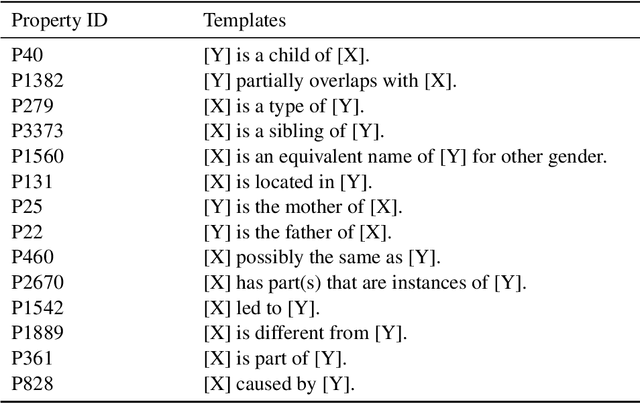
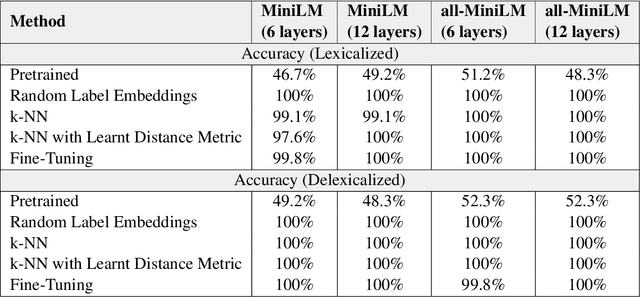
Abstract:Capturing symmetric (e.g., country borders another country) and antisymmetric (e.g., parent_of) relations is crucial for a variety of applications. This paper tackles this challenge by introducing a novel Wikidata-derived natural language inference dataset designed to evaluate large language models (LLMs). Our findings reveal that LLMs perform comparably to random chance on this benchmark, highlighting a gap in relational understanding. To address this, we explore encoder retraining via contrastive learning with k-nearest neighbors. The retrained encoder matches the performance of fine-tuned classification heads while offering additional benefits, including greater efficiency in few-shot learning and improved mitigation of catastrophic forgetting.
Collaborative Evaluation of Deepfake Text with Deliberation-Enhancing Dialogue Systems
Mar 06, 2025Abstract:The proliferation of generative models has presented significant challenges in distinguishing authentic human-authored content from deepfake content. Collaborative human efforts, augmented by AI tools, present a promising solution. In this study, we explore the potential of DeepFakeDeLiBot, a deliberation-enhancing chatbot, to support groups in detecting deepfake text. Our findings reveal that group-based problem-solving significantly improves the accuracy of identifying machine-generated paragraphs compared to individual efforts. While engagement with DeepFakeDeLiBot does not yield substantial performance gains overall, it enhances group dynamics by fostering greater participant engagement, consensus building, and the frequency and diversity of reasoning-based utterances. Additionally, participants with higher perceived effectiveness of group collaboration exhibited performance benefits from DeepFakeDeLiBot. These findings underscore the potential of deliberative chatbots in fostering interactive and productive group dynamics while ensuring accuracy in collaborative deepfake text detection. \textit{Dataset and source code used in this study will be made publicly available upon acceptance of the manuscript.
The Future Outcome Reasoning and Confidence Assessment Benchmark
Feb 27, 2025



Abstract:Forecasting is an important task in many domains, such as technology and economics. However existing forecasting benchmarks largely lack comprehensive confidence assessment, focus on limited question types, and often consist of artificial questions that do not align with real-world human forecasting needs. To address these gaps, we introduce FOReCAst (Future Outcome Reasoning and Confidence Assessment), a benchmark that evaluates models' ability to make predictions and their confidence in them. FOReCAst spans diverse forecasting scenarios involving Boolean questions, timeframe prediction, and quantity estimation, enabling a comprehensive evaluation of both prediction accuracy and confidence calibration for real-world applications.
Next Token Prediction Towards Multimodal Intelligence: A Comprehensive Survey
Dec 30, 2024



Abstract:Building on the foundations of language modeling in natural language processing, Next Token Prediction (NTP) has evolved into a versatile training objective for machine learning tasks across various modalities, achieving considerable success. As Large Language Models (LLMs) have advanced to unify understanding and generation tasks within the textual modality, recent research has shown that tasks from different modalities can also be effectively encapsulated within the NTP framework, transforming the multimodal information into tokens and predict the next one given the context. This survey introduces a comprehensive taxonomy that unifies both understanding and generation within multimodal learning through the lens of NTP. The proposed taxonomy covers five key aspects: Multimodal tokenization, MMNTP model architectures, unified task representation, datasets \& evaluation, and open challenges. This new taxonomy aims to aid researchers in their exploration of multimodal intelligence. An associated GitHub repository collecting the latest papers and repos is available at https://github.com/LMM101/Awesome-Multimodal-Next-Token-Prediction
Segment-Level Diffusion: A Framework for Controllable Long-Form Generation with Diffusion Language Models
Dec 15, 2024



Abstract:Diffusion models have shown promise in text generation but often struggle with generating long, coherent, and contextually accurate text. Token-level diffusion overlooks word-order dependencies and enforces short output windows, while passage-level diffusion struggles with learning robust representation for long-form text. To address these challenges, we propose Segment-Level Diffusion (SLD), a framework that enhances diffusion-based text generation through text segmentation, robust representation training with adversarial and contrastive learning, and improved latent-space guidance. By segmenting long-form outputs into separate latent representations and decoding them with an autoregressive decoder, SLD simplifies diffusion predictions and improves scalability. Experiments on XSum, ROCStories, DialogSum, and DeliData demonstrate that SLD achieves competitive or superior performance in fluency, coherence, and contextual compatibility across automatic and human evaluation metrics comparing with other diffusion and autoregressive baselines. Ablation studies further validate the effectiveness of our segmentation and representation learning strategies.
Decompose and Leverage Preferences from Expert Models for Improving Trustworthiness of MLLMs
Nov 20, 2024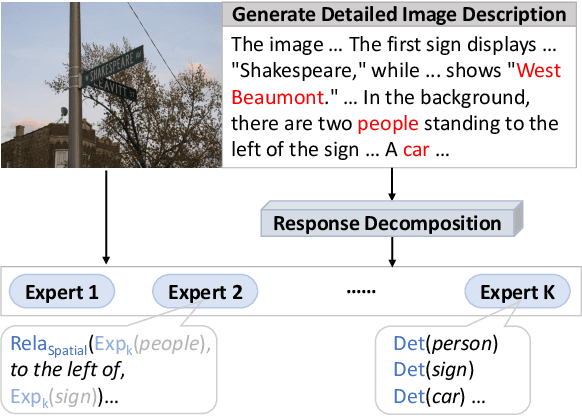
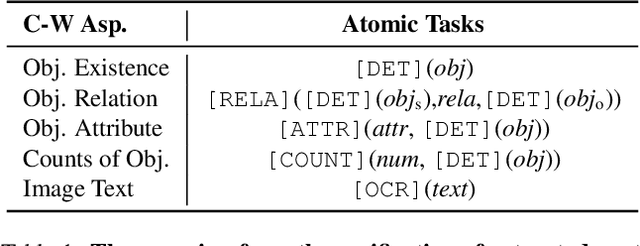
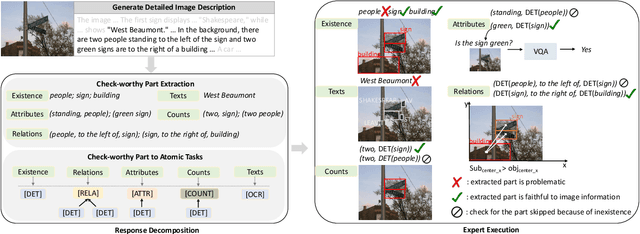
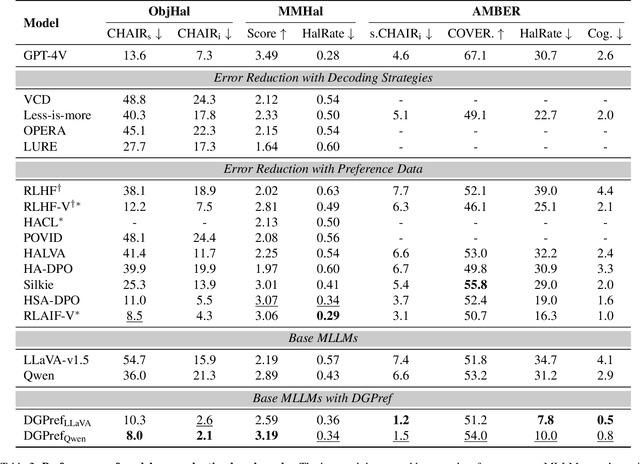
Abstract:Multimodal Large Language Models (MLLMs) can enhance trustworthiness by aligning with human preferences. As human preference labeling is laborious, recent works employ evaluation models for assessing MLLMs' responses, using the model-based assessments to automate preference dataset construction. This approach, however, faces challenges with MLLMs' lengthy and compositional responses, which often require diverse reasoning skills that a single evaluation model may not fully possess. Additionally, most existing methods rely on closed-source models as evaluators. To address limitations, we propose DecompGen, a decomposable framework that uses an ensemble of open-sourced expert models. DecompGen breaks down each response into atomic verification tasks, assigning each task to an appropriate expert model to generate fine-grained assessments. The DecompGen feedback is used to automatically construct our preference dataset, DGPref. MLLMs aligned with DGPref via preference learning show improvements in trustworthiness, demonstrating the effectiveness of DecompGen.
 Add to Chrome
Add to Chrome Add to Firefox
Add to Firefox Add to Edge
Add to Edge